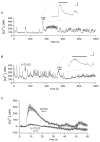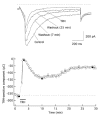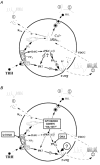Protein kinase C is necessary for recovery from the thyrotropin-releasing hormone-induced r-ERG current reduction in GH3 rat anterior pituitary cells
- PMID: 12562894
- PMCID: PMC2342738
- DOI: 10.1113/jphysiol.2002.034611
Protein kinase C is necessary for recovery from the thyrotropin-releasing hormone-induced r-ERG current reduction in GH3 rat anterior pituitary cells
Abstract
The biochemical cascade linking activation of phospholipase C-coupled thyrotropin-releasing hormone (TRH) receptors to rat ERG (r-ERG) channel modulation was studied in situ using perforated-patch clamped adenohypophysial GH3 cells and pharmacological inhibitors. To check the recent suggestion that Rho kinase is involved in the TRH-induced r-ERG current suppression, the hormonal effects were studied in cells pretreated with the Rho kinase inhibitors Y-27632 and HA-1077. The TRH-induced r-ERG inhibition was not significantly modified in the presence of the inhibitors. Surprisingly, the hormonal effects became irreversible in the presence of HA-1077 but not in the presence of the more potent Rho kinase inhibitor Y-27632. Further experiments indicated that the effect of HA-1077 correlated with its ability to inhibit protein kinase C (PKC). The hormonal effects also became irreversible in cells in which PKC activity was selectively impaired with GF109203X, Gö6976 or long-term incubation with phorbol esters. Furthermore, the reversal of the effects of TRH, but not its ability to suppress r-ERG currents, was blocked if diacylglycerol generation was prevented by blocking phospholipase C activity with U-73122. Our results suggest that a pathway involving an as yet unidentified protein kinase is the main cause of r-ERG inhibition in perforated-patch clamped GH3 cells. Furthermore, they demonstrate that although not necessary to trigger the ERG current reductions induced by TRH, an intracellular signal cascade involving phosphatidylinositol-4,5-bisphosphate hydrolysis by phospholipase C, activation of an alpha/betaII conventional PKC and one or more dephosphorylation steps catalysed by protein phosphatase 2A, mediates recovery of ERG currents following TRH withdrawal.
Figures









Similar articles
-
Modulation of rat erg1, erg2, erg3 and HERG K+ currents by thyrotropin-releasing hormone in anterior pituitary cells via the native signal cascade.J Physiol. 2001 Apr 1;532(Pt 1):143-63. doi: 10.1111/j.1469-7793.2001.0143g.x. J Physiol. 2001. PMID: 11283231 Free PMC article.
-
Modulation of human erg K+ channel gating by activation of a G protein-coupled receptor and protein kinase C.J Physiol. 1998 Sep 1;511 ( Pt 2)(Pt 2):333-46. doi: 10.1111/j.1469-7793.1998.333bh.x. J Physiol. 1998. PMID: 9706014 Free PMC article.
-
The erg-like potassium current in rat lactotrophs.J Physiol. 1999 Jul 15;518 ( Pt 2)(Pt 2):401-16. doi: 10.1111/j.1469-7793.1999.0401p.x. J Physiol. 1999. PMID: 10381588 Free PMC article.
-
The novel and specific Rho-kinase inhibitor (S)-(+)-2-methyl-1-[(4-methyl-5-isoquinoline)sulfonyl]-homopiperazine as a probing molecule for Rho-kinase-involved pathway.Pharmacol Ther. 2002 Feb-Mar;93(2-3):225-32. doi: 10.1016/s0163-7258(02)00191-2. Pharmacol Ther. 2002. PMID: 12191614 Review.
-
[Rho-kinase inhibitor].Nihon Rinsho. 2004 Feb;62 Suppl 2:571-4. Nihon Rinsho. 2004. PMID: 15035192 Review. Japanese. No abstract available.
Cited by
-
Muscarinic modulation of erg potassium current.J Physiol. 2004 Aug 15;559(Pt 1):67-84. doi: 10.1113/jphysiol.2004.066944. Epub 2004 Jul 2. J Physiol. 2004. PMID: 15235086 Free PMC article.
-
Phosphatidylinositol 4,5-bisphosphate interactions with the HERG K(+) channel.Pflugers Arch. 2007 Oct;455(1):105-13. doi: 10.1007/s00424-007-0292-5. Epub 2007 Jul 11. Pflugers Arch. 2007. PMID: 17622552 Review.
-
Participation of HERG channel cytoplasmic structures on regulation by the G protein-coupled TRH receptor.Pflugers Arch. 2009 Apr;457(6):1237-52. doi: 10.1007/s00424-008-0599-x. Epub 2008 Nov 6. Pflugers Arch. 2009. PMID: 19002712
-
Modulation of hERG potassium currents in HEK-293 cells by protein kinase C. Evidence for direct phosphorylation of pore forming subunits.J Physiol. 2007 Jun 1;581(Pt 2):479-93. doi: 10.1113/jphysiol.2006.123414. Epub 2007 Mar 15. J Physiol. 2007. PMID: 17363390 Free PMC article.
-
Thyrotropin-releasing hormone increases phospholipase D activity through stimulation of protein kinase C in GH3 cells.Endocrine. 2004 Feb;23(1):33-8. doi: 10.1385/ENDO:23:1:33. Endocrine. 2004. PMID: 15034194
References
-
- Akita Y, Ohno S, Yajima Y, Konno Y, Saido TC, Mizuno K, Chida K, Osada S, Kuroki T, Kawashima S, Suzuki K. J Biol Chem. 1994;269:4653–4660. - PubMed
-
- Arcangeli A, Rosati B, Cherubini A, Crociani O, Fontana L, Ziller C, Wanke E, Olivotto M. HERG- and IRK-like inward rectifier currents are sequentially expressed during neuronal development of neural crest cells and their derivatives. Eur J Neurosci. 1997;9:2596–2604. - PubMed
-
- Barros F, Del Camino D, Pardo LA, Palomero T, Giráldez T, de la Peña P. Demonstration of an inwardly rectifying K+ current component modulated by thyrotropin-releasing hormone and caffeine in GH3 rat anterior pituitary cells. Pflugers Arch. 1997;435:119–129. - PubMed
-
- Barros F, Delgado LM, Del Camino D, de la Peña P. Characteristics and modulation by thyrotropin-releasing hormone of an inwardly rectifying K+ current in patch-perforated GH3 anterior pituitary cells. Pflugers Arch. 1992;422:31–39. - PubMed
-
- Barros F, Delgado LM, Maciá C, de la Peña P. Effects of hypothalamic peptides on electrical activity and membrane currents of ‘patch perforated’ clamped GH3 anterior pituitary cells. FEBS Lett. 1991;279:33–37. - PubMed
Publication types
MeSH terms
Substances
LinkOut - more resources
Full Text Sources

